Zone of Scenius
Zuzalu, popup villages, and building at the edges — my experience at popup villages and thoughts on the future of networked communities
Author’s note: this post also lives on the Edge City website.
My first “cold” plunge happened in the Adriatic Sea the morning I arrived at Zuzalu. The clear blue water was more lukewarm than cold, to be fair, since it was already well into April, but joining the morning ritual was a refreshing welcome, relaxing some of the apprehension that had followed me to Montenegro.
As I floated with a group of strangers (including one well-known podcast host who was leading the session), I was surprised at how quickly my sense of unfamiliarity began to thaw. We joked around and discussed our plans for the day. Would I be checking out the zero-knowledge workshop that afternoon? Maybe, although I had to find time to plan the AI weekend that I was helping to organize. Ah, cool, they said; they were really looking forward to that one.
A small group of us ended up spending the morning together, flowing effortlessly from the ocean to breakfast (broccoli and lentils inspired by Bryan Johnson), to an impromptu talk on the pier (about the aging process of cells), to a fun encounter with a group excitedly building AI that could track thousands of data inputs from the local river (one of the last wild rivers in Europe). I was struck by how open and interesting everyone I met was. It was somewhat intimidating but mostly exciting.
This mini-adventure was a microcosm of the variety of experiences that a well-designed popup village allows for. The first few days verged on overwhelming, but once I got into the flow of the experience, I began to decorate my time by exploring my interests and letting serendipity guide me.
Popup villages
How did we get there?
Around this time last year, 200 people decided to move in together for two months in a small seaside resort in Montenegro. During that time, another 800 visitors joined them, many of whom intended to come for just a week but prolonged their stays. The crowd was eclectic—a mix of technologists, scientists, academics, engineers, cultural figures, and entrepreneurs.
This gathering, Zuzalu, was the slightly chaotic yet much-beloved beginning to what is now shaping up to be a new movement. ‘Popup villages’ are attracting large groups of people to live together in co-created communities for multiple months at a time and are serving as a way to bootstrap global networked communities.
The Zuzalu event expanded the adjacent possible, demonstrating that this type of gathering was viable and directly spawning a large number of spinoffs, each organized by someone who was at the first event and each with their own areas of focus: Edge City (what I’m building with Janine), Vitalia (focused on longevity), Mu (focused on hackers), and many others, all pushing the format in various ways. If you wanted to, you could now spend the rest of 2024 solely living in a popup village, going from one to the other.
There is plenty of historical precedent for similar things, from the Chautauqua Movement in the late 1800s to various attempts at utopian communities during the cultural renaissance of the 1960s. Now, these ideas have new life, initially reignited by nomad-adjacent folks who are seeking community, although it is quickly growing beyond that initial demographic.
Why are people drawn to these popup villages, and why do they talk about the experiences as transformational? I want to explore these questions through my own experience to see what this new format means for communities and technologies going forward.
What actually is a popup village?
It’s worth briefly defining the concept. These events, with their longer durations, multidisciplinary focus, and emergent programming, are distinct from typical gatherings.
Unlike industry conferences, which can gather similar numbers of people but last only a few days, popup villages last at least a month, allowing deeper connections and more meaningful collaborations. They cover many topics, provide ample time and space for in-depth projects and experiments, and foster a holistic experience that integrates many parts of life.
Unlike hacker houses or residencies, which can last similar amounts of time but involve much smaller groups, popup villages accommodate several hundred people. This creates a full community experience where participants live, cook, and embark on adventures together, allowing them to express many facets of their personalities.
Popup villages seem to hit a sweet spot in size and length. Vitalik Buterin, the creator of Zuzalu, put it well: “A two-day conference is a break from your life, but a two-month-long event is your life.” If you’re living somewhere for over a month, you’ll put in the effort needed to get comfortable and integrate into the experience.
Express yourself
An important aspect of popup villages is that the immersive environment and variety of experiences allow you to express multiple sides of your personality and bring your whole self to the container. At Zuzalu, I was able to learn from experts in many fields, have in-depth discussions, DJ with Grimes, be playful with friends, cook group meals, do intense workouts, practice handstands, meditate in the morning, and enjoy quiet time reading in my room.
This ability to fully express myself and be surrounded by others doing the same created a continuous stream of meaningful experiences and a quick sense of affinity with those around me. Definitely not a typical conference.
If we make up a metric for how authentic and holistic we are in an environment (i.e., how many parts of ourselves can be expressed), like a ‘Holistic Expression Index,’ then I think it would have a very tight correlation with the Depth of Connection that we feel with other humans in those environments.
My personal corresponding chart might look something like this, and I would put well-designed popup villages directly in the top right.
Accelerators of kinship
So what happens when several hundred people live together in an environment that fosters exploration, learning, self-expression, and meaningful connections? The result is deep community ties and a lot of new ideas.
Popup villages act as accelerators of kinship and affinity. Strong communities are built on shared experiences, which create a sense of a shared past and a vision for a shared future. These bonds are further reinforced through active collaboration. You might meet someone at a talk, discuss ideas during a walk the next day, and then team up for a hackathon the following week.
This is important because communities are crucial for human flourishing. In a great essay, Brink Lindsey argues that strong personal relationships and community ties are essential not just for individual well-being but for societal sustainability and equity. He emphasizes that building and maintaining strong relationships requires shared activities and responsibilities.
"To build and maintain strong relationships, people need to do things together — even if the thing in question is just hanging out. People need to share responsibilities and engage in joint projects. They need to depend on each other."
These communities will go beyond just the time and place where they are instantiated. Popup villages are incubators for future networked communities, which have the capacity to become significant entities like network cities or network societies (more on that below).
Toby Shorin, the creator of Other Internet, had a great line in a chat we had a few weeks ago:
“Pop-up cities are an angle on the big question of our time: what are social forms that can overcome the technological disintermediation of our social lives that we’ve been living with and create new robust, lasting social ties?”
I think that’s a great take. And, importantly, the connections transcend just the time and place where the popups happen. Now, just a year into this movement, there is a global network of people who have a shared experience that bonded them and have gone back to their respective homes to spread what they’ve learned and incubated. Unlike the 'back to the land' movements of the 1960s, where people decided to remove themselves from society completely, we are all digitally connected, so we don't need to separate ourselves from the world.
Novel ideas and technology incubated in popup villages can spread digitally and physically, expanding their impact.
From zone of genius to zone of scenius — incubating new technologies
Beyond accelerating kinship, popup villages offer a unique environment for incubating new ideas and technologies.
When a large number of smart, high-agency people gather, each bringing their area of expertise, the environment can foster the merging of their individual zones of genius into a collective form—something like a ‘zone of scenius.’ This concept, inspired by Brian Eno’s term 'scenius,' refers to the collective genius that emerges from a community, combining their unique collective abilities and areas of interest. Zones of scenius thrive in environments with a rapid collision of ideas and strong community network effects between participants.
It’s no surprise that people who work in frontier fields like AI, BioTech, and Crypto are initially the ones most drawn to these experiments and form the early majority of attendees. Folks in these industries are building at the edges of possibility and they need a community to collaborate with. Early ideas—especially the unconventional or seemingly bad ones—require a supportive space to develop.
Zac Williamson, the co-founder and CEO of Aztec, put it well in a chat we had:
“All great ideas start out as terrible ideas, and you need people who are willing to engage with you and help you iterate and refine your ideas to figure out if it is actually just bad or decent…. I see what Zuzalu and Edge City are doing as creating scenes that can act as a crucible for innovation in emergent industries.”
Popup villages provide that supportive space, allowing participants to explore unusual side projects and find collaborators. The multidisciplinary nature of these gatherings also facilitates cross-field learning and innovation. These scenius environments can enable the critical ‘zero to one’ moments for groundbreaking ideas, and the strong ties formed in these environments can sustain builders through the inevitable ‘winters’ that come to all innovative industries.
Another advantage is that villages often take place around the world outside of traditional urban hubs. This setting allows builders to step outside their usual bubbles, exposing them to diverse influences and novel experiences. It’s an environment that fosters new ideas and enables participants to meet people they wouldn’t encounter in their usual routines.
What is being built?
Each village has a different focus and comparative advantage, although I think the current batch all lend themselves well to projects related to community, identity, and real-world applications of frontier tech. To help paint the picture, I’ll share a couple of examples from the countless projects that were built.
ZuPass is an identity system based on zero-knowledge proofs that was built during Zuzalu and has been used at many events since, including the large conference DevConnect and our event Edge City Denver. It was built by the 0xPARC team, who wanted to showcase real-world use-cases of the cryptographic primitive Proof Carrying Data. It allows people to check in to events and participate in governance votes by proving cryptographically that they are members of the community without revealing anything about their identity. The implications for digital democracy, privacy, and social interactions are endless. We are huge fans of these ideas at Edge City and will continue to create spaces for the growing ZuPass ecosystem to be developed further.
Daimo was built as a direct response to a problem that DC and Nalin noticed at Zuzalu — no one was using crypto to split bills between each other. They quickly built a prototype of an app that allows you to do everything that Venmo or PayPal can do, but onchain using the stablecoin USDC, with free transactions. They developed it in the months between Zuzualu Montenegro in May and ZuConnect (the second major event we did in Istanbul) in October. The product experience feels like magic to anyone who is used to dealing with crypto transactions directly.
In just twelve months since Zuzalu started, hundreds of other companies/hackathon projects/funds/network cities have been conceptualized/built/scaled at these events. The regular nature of the villages, with several months in between, also offers multiple opportunities to iterate on concepts, showcasing progress between gatherings.
Popup villages tend to be designed for emergence, so it’s hard to say what will be built beforehand, but that’s what makes them so exciting. People have an idea, see an opportunity or identify a potential issue, and build something to address it.
But technologists are not the only ones who are building at the edges.
Social Technology
For me, the important aspect of these gatherings is not just the software or hardware technology that gets incubated. Rather, these villages are perfect places to incubate new ‘social technology’—the norms, practices, and rituals of being in community with others. They are the perfect testing ground for new ideas about how people can live together and interact with one another.
Popup villages open a new design space for what it takes to create and govern meaningfully sized communities, that is, communities sized Dunbar’s Number or greater. The long length means stakes are high, and it’s necessary to figure out how to get along, but they are not forever, so new ideas can be tried without the red tape of current cities or the inertia caused by the fear of permanence. It’s ambitious but manageable.
It’s exciting that we will have dozens more experiments soon. As I’ve written before, it is important that we run many concurrent bottoms-up experiments in governance, community-building, and economic models. Humanity’s history is full of creativity in these areas that modernity seems to have forgotten.
Matt Prewitt, the president of RadicalxChange, wrote about the importance of this in an excellent essay:
“The drivers of social coherence, such as culture, governance, morality, law, shared stories, and shared values, might as well be considered “technologies.” … Without progress in our techniques of deepening and expanding community, all other technical progress will evolve without reason or direction, eventually snagging on internal and external contradictions.”
I agree with Matt. As technology accelerates, it is perhaps just as important to innovate on how we interact together as humans. Popup villages provide a unique opportunity to test and refine these ideas in real-world settings, paving the way for more cohesive, resilient, and adaptive communities in the face of rapid technological change. To do this well, the number and scope of villages need to grow to include many that aren’t just filled with mostly scientists and tech folks but feature intersectional communities that bring together people from all aspects of life (that is an aspiration of ours at Edge City, although it will take time).
These ideas become even more interesting when we consider the formation of new types of networks that transcend national boundaries.
Example: New networks
I happened to be at Zuzalu during the ‘Coordi-nations’ week, which was a great example of the potential of these types of gatherings in cultivating new social technology.
It was organized by Primavera de Filippi and Jessy Kate Shingler, both Harvard academics. They brought together a small group of leading researchers and builders from diverse backgrounds to incubate the idea of “Coordi-nations,” a new type of organizational structure that aims to foster cooperation at both local and global scales through shared values and participatory decision-making.
Many similar ideas to network states were discussed at length in Zuzalu and served as part of the initial inspiration for the event. I resonated particularly with the Coordi-nations emphases on mutualism and solidarity. Whatever form these networks take, the potential for global communities that transcend national boundaries is huge. These networks could eventually help tackle global issues that current institutions are currently struggling to manage due to coordination problems.
But they are extremely difficult to grow, so they need to start with a strong foundation of connection between the people building them, to allow them to weather the challenges ahead. They need to start with a group of people who actually care about each other, not just the broader vision.
This is why popup villages will serve as a critical IRL touchpoint to bootstrapping these novel types of networks by providing a context for the communities to bond. Over time, through meaningful shared experiences, people may feel a stronger kinship with these networks than with their traditional sources of identity, like their country of birth or residence.
As Primavera and Jessy Kate wrote in their write-up of the workshop:
“Coordi-nations are an emergent form of networked sovereignty. They rely on networked communities as an animating force for cooperation, collaboration, mutualism, and solidarity in a context of growing global interdependencies. The growth of networked communities may have significant implications for global governance, global trade and mobility.”
Was a popup village necessary to further this idea? I think so. The format of Zuzalu offered several boons to the idea of coordi-nations and network societies more broadly:
Container: It gave space to the group of thinkers to incubate the ideas;
Feedback loop: It allowed them to present their concepts to the wider community, getting immediate thoughts and feedback;
Demonstration: Most importantly, Zuzalu was itself a proto-example of the very type of social technology innovation that is being discussed. Hence, it fed into the ideation and provided evidence and a potential path for how these ideas can actually be instantiated.
This is a very intriguing area of research, and we are excited to host Primavera and her crew at our upcoming Edge City event, Edge Esmeralda, to further their investigation and build a framework to make it tangible. This is one example of many powerful ideas that benefit from environments like this which will get incubated in the future. I hope to write about others soon.
Challenges and learnings
It’s important to be open about the challenges that these types of events bring and the lessons we’ve already learned. Different approaches will yield different lessons, and they’ll allow us all to iterate faster.
We are fortunate to work in a space where everyone is building in public (we created an open-source ops playbook from Zuzalu for anyone curious!). I can already feel some light competition between the various spinoffs, but everyone is mostly friendly and excited to share what they’ve learned.
Some of the challenges we’ve noticed:
Organizer burnout: it is hard to bring this many people together for this long. It takes an insane amount of work to do it well.
Short-term attendance: we’ve noticed that attendees are often tempted to just come for a weekend or a week, but then they do not get as much out of the experience. In fact, they can often have a bad time because they don’t fit into the natural flow of things.
Infra challenges: current infrastructure isn’t set up for this type of event yet. Finding the right spaces is difficult, and it’s difficult for people to carve out long chunks of their year to do something like this.
Community management: any gathering that brings together lots of people in one place can be difficult to manage. Conflicts are inevitable, and you have to be thoughtful to make it a safe and fun space for people.
Inclusivity vs. capacity and curation: there is a tension between inclusivity and respecting the space's boundaries. On the one hand, you want to be open and encourage everyone to come. On the other hand, events are, by definition, exclusive due to physical capacity constraints.
It is also important to curate attendees thoughtfully to ensure a good environment for everyone. This isn’t an easy thing to solve, and it is an ongoing area of thought for everyone organizing these types of events.
Our current thinking for solving this is to open-source all of our learnings and encourage others to do the same. If folks might not be a good fit for one event, they could be great for another.
Local Integration: These gatherings take place in various international locations. When bringing people from around the world to a new place, it's important to be very thoughtful about how to integrate with the local communities and to ensure that attendees are thoughtful as well. We’ve spent a lot of time forging deep relationships with local partners to try our best to do this.
As we continue to refine and improve these gatherings, we’ll keep sharing what we learn. With each event, we get noticeably better and gain invaluable insights that help us create more cohesive communities.
Looking forward
That initial plunge in the Adriatic led to a habit—I have likely done over fifty cold plunges since then, and most of them have been actually extremely bloody cold (it’s always pain; I'm not sure why I keep doing it 🙃). But what I remember most from that morning are the connections I made, which have remained warm. These lasting relationships are a testament to the bonds that can be formed in such immersive environments.
When people connect within a specific context like Zuzalu, it creates strong connections, not just between the people but also with the overall idea of Zuzalu. Now, when I meet people who were also there, we bond over our mutual affinity for that community, even if we didn’t meet there at the time. The web of connection grows, and I feel simultaneously closer to them and to the community that we’re both a part of.
These communities will intertwine with each other through people who belong to multiple of them. Zuzalu, Edge City, Vitalia, Mu, ZuGeorgia etc. are all interconnected through the people they share. They are starting to weave a growing decentralized tapestry of connections.
This interconnectedness will foster a growing zone of scenius, where the collective genius of the communities combines to drive creativity and progress.
If that’s interesting to you, feel free to reach out on Twitter and follow along with what we’re building at Edge City 🌞
Thank you, Chance, Arthaud, and Dan Hunt, for taking a read, Janine for a lot of ideas, Olga Kuri for most of the amazing art here, and to everyone involved in Zuzalu and the growing ecosystem for inspiring this movement.

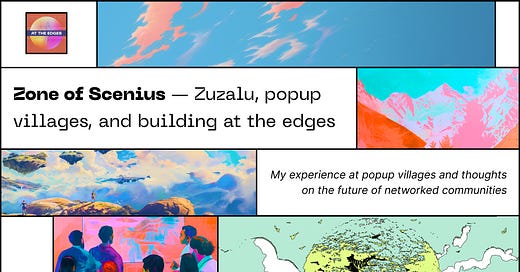




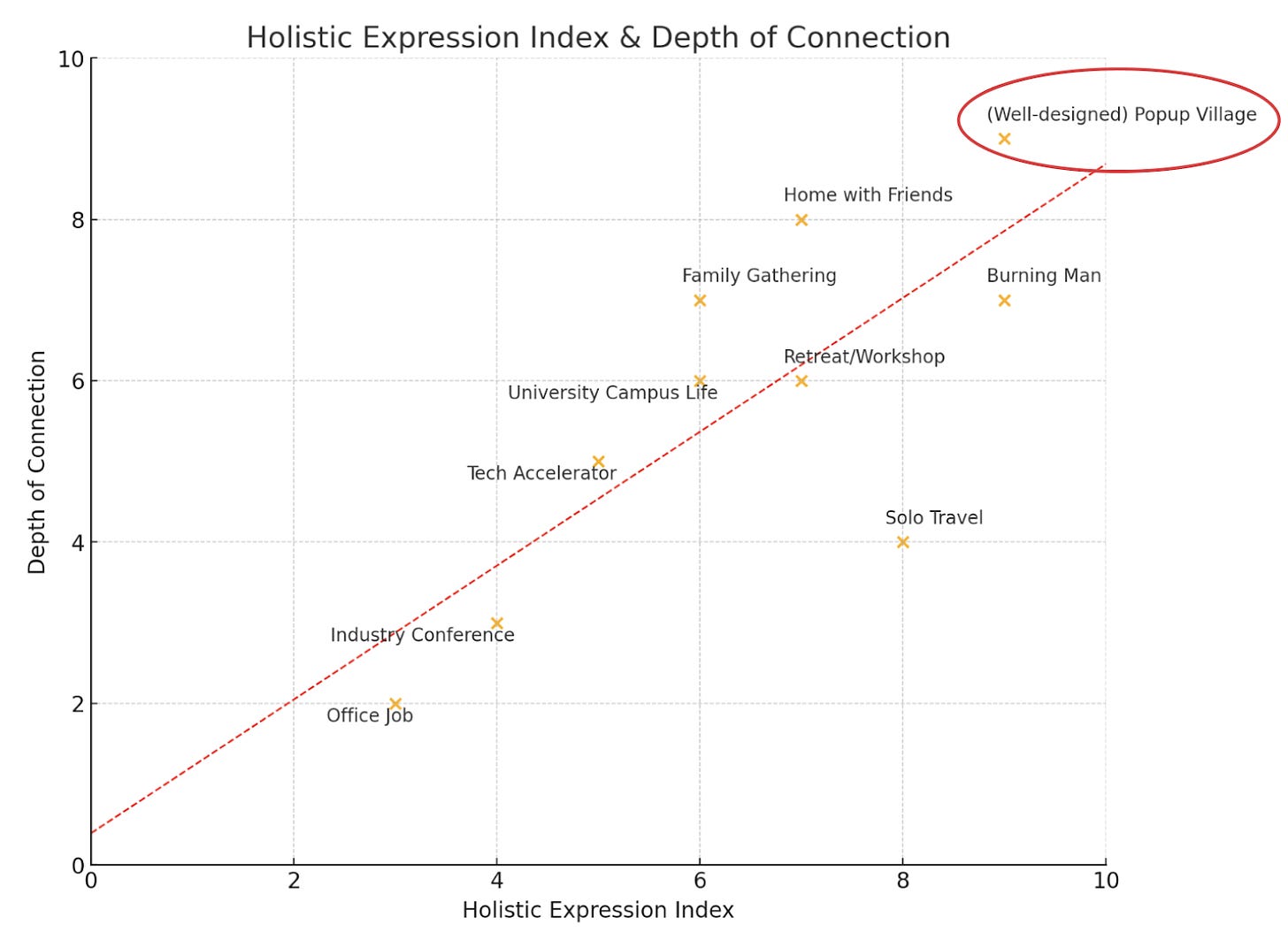

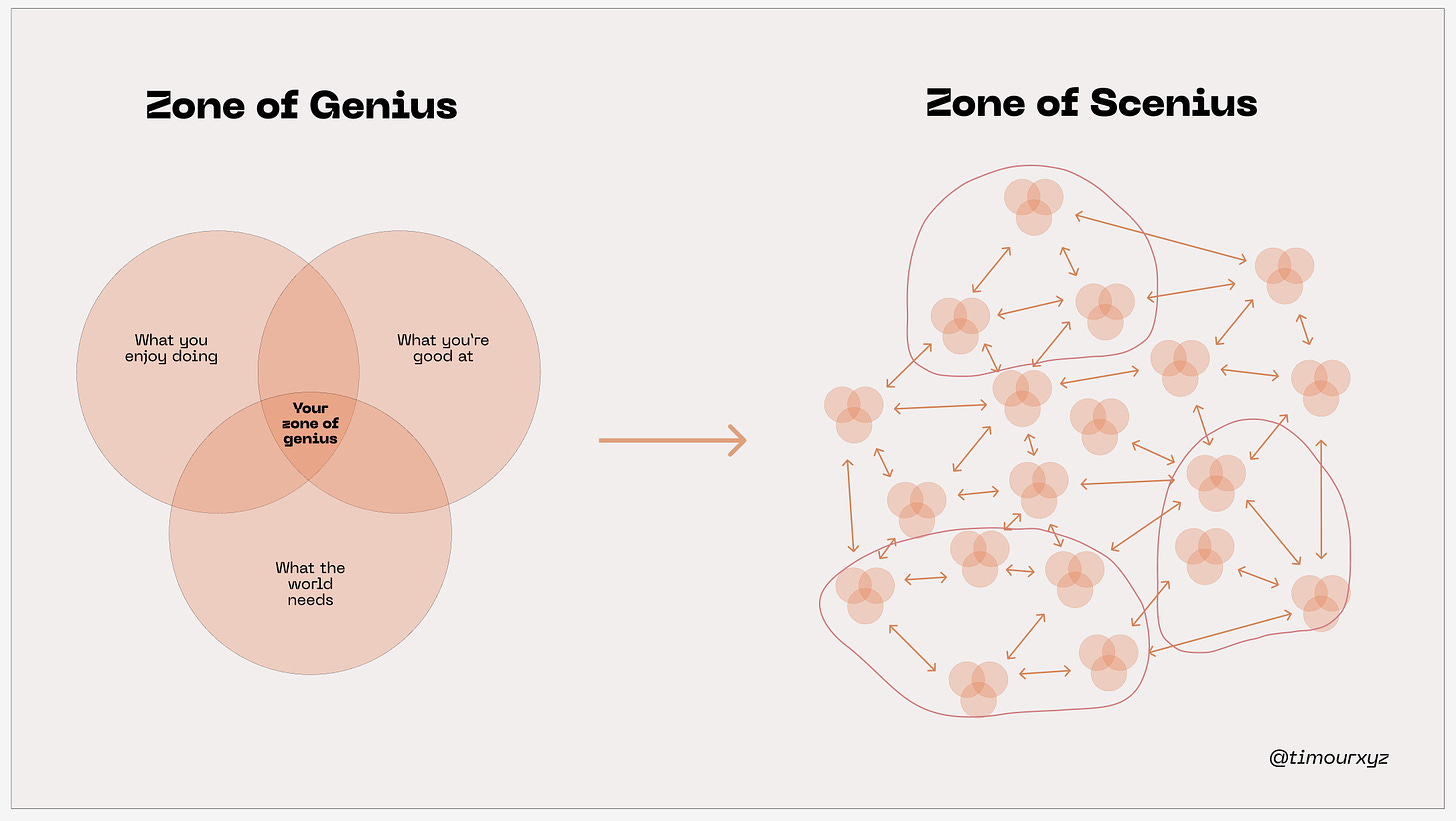
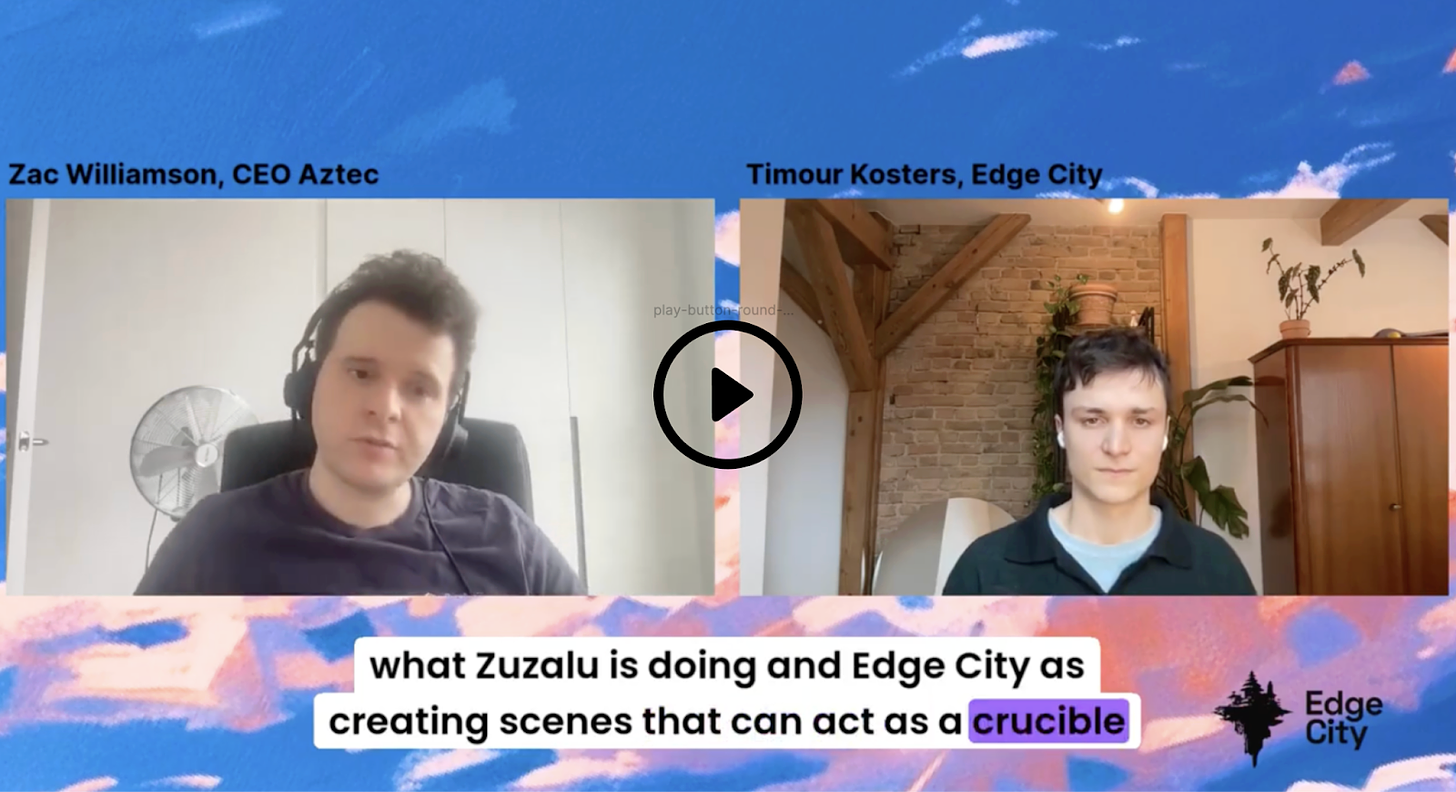

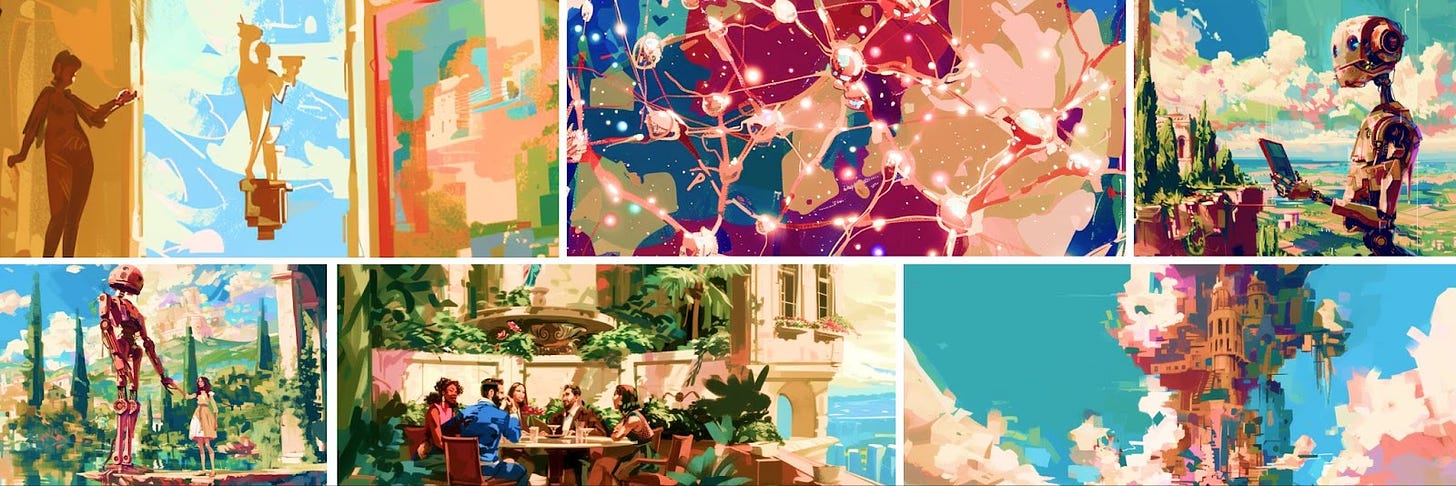
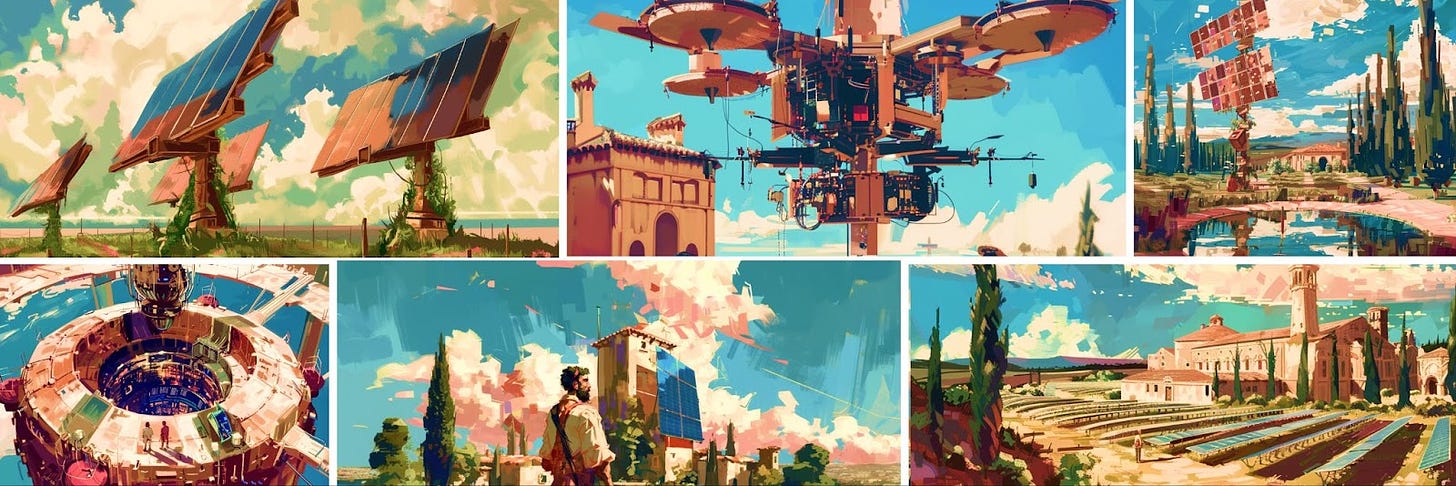
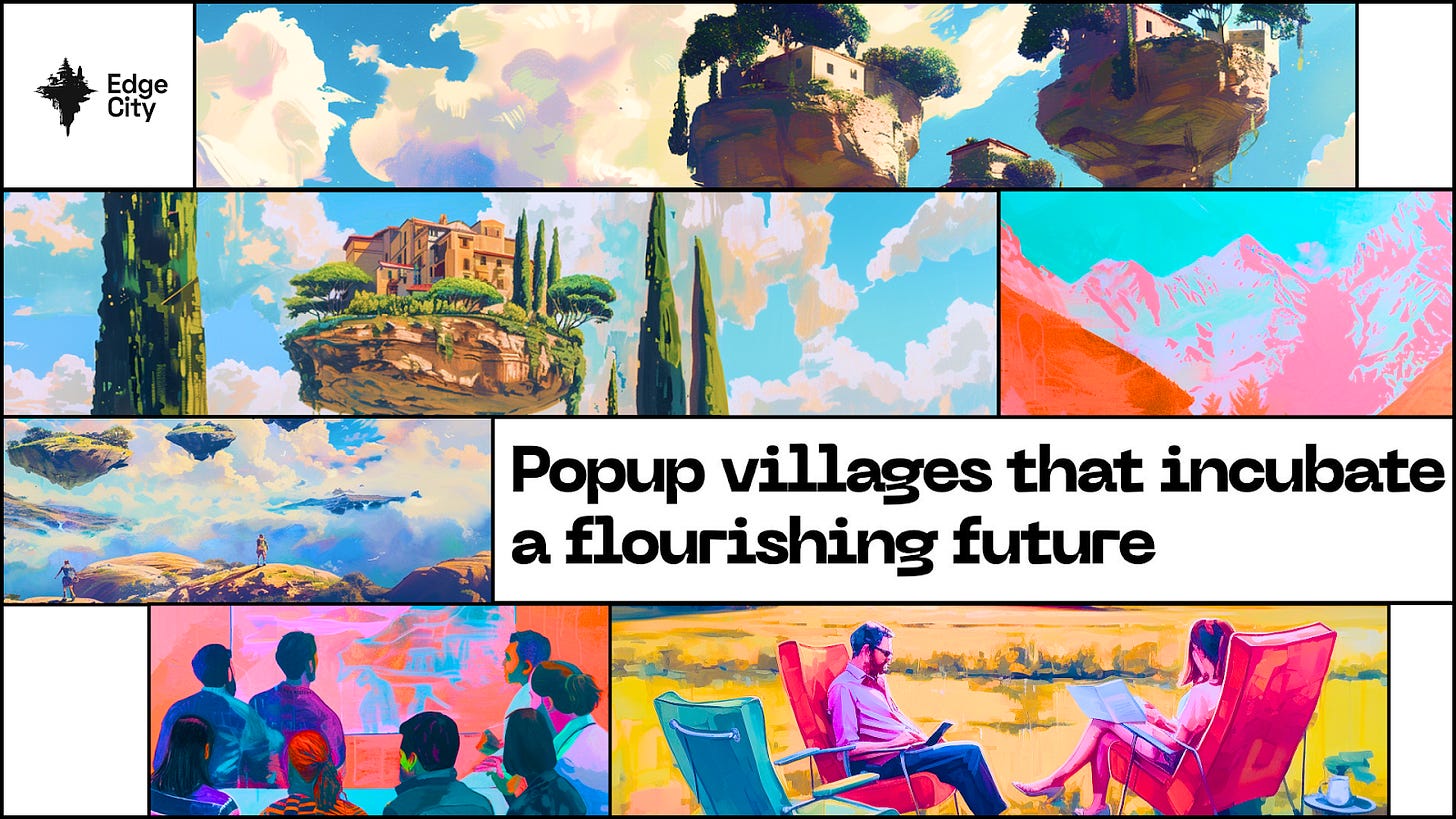
Great piece! Gutted I can't make Edge Esmerelda but I will be at ZuBerlin. We have also just launched the site for https://futurecraft.life/ that I think you will like